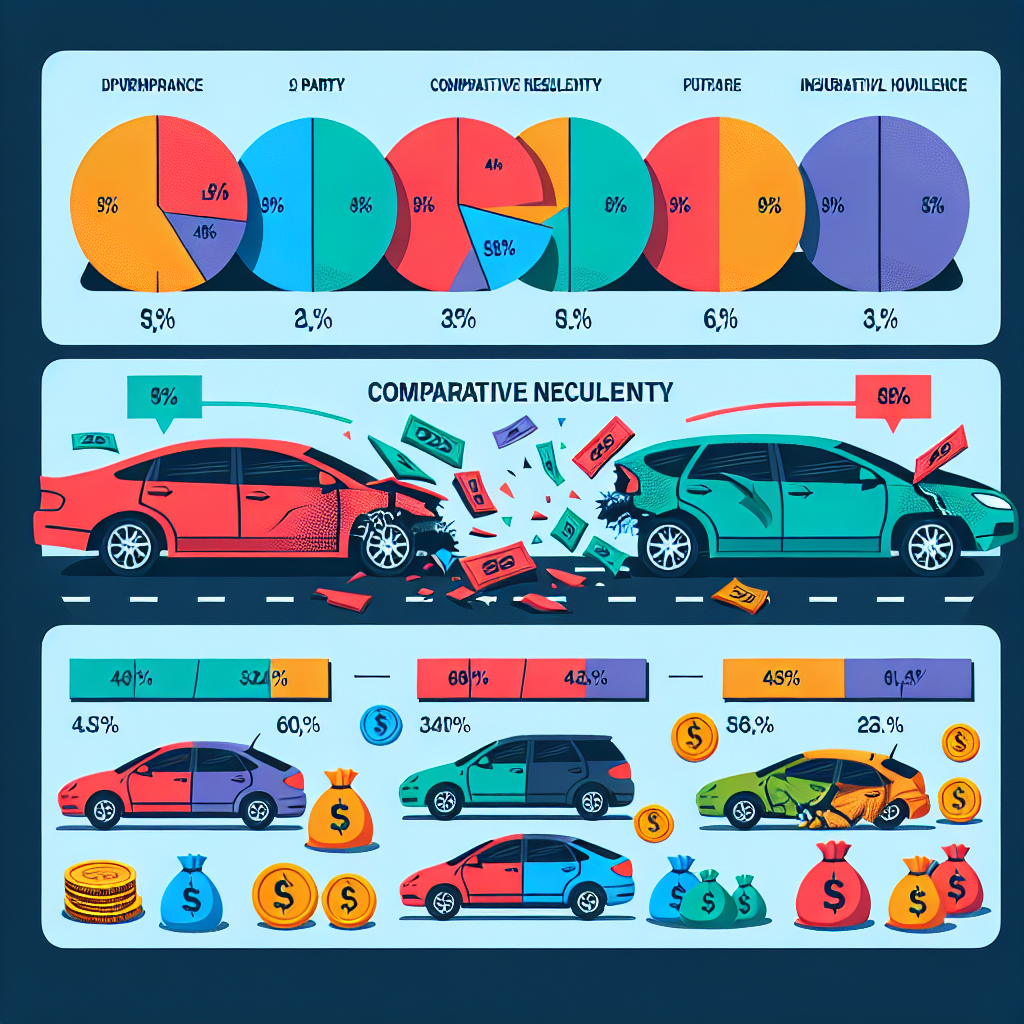Comparative Negligence: How it Affects Your Legal Case
Introduction
Welcome to the wild world of comparative negligence, where fault isn’t just a feeling it’s a legal battleground! If you’ve ever been in an accident or faced a personal injury claim, you might have heard the term “comp negligence” tossed around like a frisbee at a summer picnic. But what does it really mean? Spoiler alert: it’s more than just legal jargon.
In the realm of negligence law, understanding how liability is assessed can make or break your case. Think of comparative negligence as a pie chart of responsibility everyone gets a slice based on their level of fault. This means if you’re partially to blame for an accident, it doesn’t mean you’re out of luck when it comes to compensation. Instead, your share of the blame will affect how much you can recover.
As we dive into this topic, we’ll explore the intricacies of how fault determination works, the differences between contributory and comparative negligence, and why knowing these distinctions is crucial in personal injury cases. Whether you’re navigating negligence litigation or just curious about how these laws play out in real life, stick around! By the end, you’ll be armed with knowledge that could change the way you approach legal matters.

Understanding Comparative Negligence
So, what exactly is comparative negligence? In simple terms, it’s a legal doctrine used in personal injury cases to determine how much fault each party bears in an accident. Think of it as a pie chart of blame; if you’re 30% at fault for your mishap, you can only claim 70% of the damages. This approach contrasts sharply with contributory negligence, which can completely bar recovery if you’re even slightly at fault. Talk about a harsh penalty!
Comparative negligence comes in two flavors: pure and modified. Under the pure comparative negligence rule, you can recover damages no matter how much fault you share even if it’s 99%. On the other hand, modified comparative negligence allows recovery only if your fault is below a certain threshold, usually 50% or 51%. This means if you’re deemed more responsible than that magic number, you’re out of luck!
Key Takeaway: Understanding whether your state follows pure or modified comparative negligence can significantly influence your legal strategy and potential compensation in personal injury cases.
The importance of comparative negligence in personal injury law cannot be overstated. It helps ensure that liability is fairly assessed and that victims still receive compensation even when they share some responsibility for their injuries. This makes the legal landscape more equitable and reflective of real-life situations where multiple parties may contribute to an accident.
In the world of tort law, where every detail counts, knowing how these standards apply can make or break your case. So whether you’re navigating a car accident claim or any other type of injury situation, keep comparative negligence on your radar!
The Role of Fault Determination
In the thrilling world of comparative negligence, fault determination is like the referee in a sports game crucial for deciding who gets the trophy (or, in this case, the compensation). Understanding how fault is assessed can make or break a legal case, especially when navigating the murky waters of negligence law.
What is Fault Determination?
Fault determination involves figuring out who was responsible for an accident and to what extent. Think of it as piecing together a puzzle where each piece represents a party’s actions leading to an incident. This process is essential in establishing liability and determining how much each party should pay in damages. In shared liability cases, where multiple parties are at fault, this becomes even more critical.
How Liability Assessment Works in Negligence Cases
The liability assessment process typically involves:
- Collecting evidence from the accident scene.
- Interviewing witnesses to get different perspectives.
- Analyzing police reports and medical records.
- Consulting experts if necessary to clarify complex issues.
This thorough investigation helps establish each party’s degree of negligence, which is crucial under both modified comparative negligence and pure comparative negligence rules. The outcome? A clear picture of who owes what and how much!
The Impact of Shared Fault on Legal Outcomes
Shared fault can dramatically alter the landscape of a legal case. If both parties are found to be negligent, courts will use fault apportionment methods to determine compensation. Here’s how it works:
- If you’re 30% at fault for an accident and the other party is 70% at fault, you can only recover 70% of your damages.
- This means that understanding your own level of responsibility and that of others is vital when filing a negligence claim.
- The comparative fault rule varies by state; some states employ modified comparative negligence while others use pure comparative negligence rules.

Key Takeaway: The role of fault determination isn’t just about assigning blame; it’s about ensuring fair compensation based on each party’s level of responsibility. Understanding this process can significantly impact your injury compensation claims!
Legal Standards for Negligence
When diving into the waters of negligence law, it’s crucial to understand the legal standards that govern how negligence claims are evaluated. Think of these standards as the rules of a game without them, chaos reigns!
- Overview of negligence law and standards: At its core, negligence involves a failure to exercise reasonable care, resulting in harm to another person. This is where the law steps in to determine whether that failure constitutes legal liability.
- Differences between modified and pure comparative negligence rules: Here’s where things get interesting!
- Modified Comparative Negligence: In many states, if you’re found to be more than 50% at fault for an accident, you can’t recover damages. It’s like trying to win a race while tripping over your own shoelaces!
- Pure Comparative Negligence: On the flip side, some states allow you to recover damages even if you’re mostly at fault just not for your share of the blame. So if you’re 90% at fault but your damages are ,000, you could still snag ,000. Cha-ching!
- Joint and several liability explained: This concept can feel like a group project gone wrong. In cases where multiple parties are found negligent, joint and several liability allows a plaintiff to recover the full amount of damages from any one of the defendants. Imagine being able to pick on just one group member for all their shared faults sounds tempting, right?
Key Takeaway: Understanding these legal standards is vital for navigating your negligence claim effectively. The distinction between modified and pure comparative negligence can significantly impact your compensation potential.
Applying Comparative Negligence in Legal Cases
When it comes to comp negligence, understanding how fault is divided in legal cases is crucial. Imagine you and a friend are playing dodgeball, and you both accidentally hit each other at the same time. Who gets the blame? In legal terms, this is essentially what happens in many accident cases where comparative negligence applies.
The process of fault apportionment in accidents is like dissecting a pie everyone gets a slice based on their contribution to the mishap. Here’s how it typically works:
- Fault Apportionment: In a comparative negligence system, the jury or judge evaluates how much fault each party bears. For example, if you were 30% at fault for an accident and the other party was 70% at fault, your compensation would be reduced by your percentage of fault.
- Assessing Negligence Percentage: To determine a defendant’s negligence percentage, evidence such as witness statements, police reports, and expert testimony are considered. This process is akin to piecing together a puzzle every piece matters to see the full picture of liability.
- Plaintiff’s Fault Contribution: If you’re the plaintiff in a negligence claim, your own contribution to the accident can significantly impact your recovery. For instance, if you were found to be 20% at fault for an incident where damages total 0,000, you would only be eligible for ,000 in compensation under most comparative negligence rules.
Key Takeaway: Understanding how comparative negligence works helps you grasp potential outcomes for your case. Always consider how shared fault could influence your injury compensation claims!
The nuances of these assessments can lead to complex negotiations during settlement discussions or litigation. Misunderstanding or misrepresenting your own level of fault can lead to dire consequences for your case. So remember: honesty is not just the best policy; it’s also essential when navigating through the intricacies of negligence litigation.

Navigating Shared Liability Cases
When it comes to shared liability cases, think of it as a complicated dance where everyone has a role to play, and sometimes, the steps get tangled. Understanding how shared fault works can be crucial in the tort claims process, especially when multiple parties are involved in an accident.
Understanding Shared Liability in Tort Claims Process
Shared liability means that more than one party is responsible for an accident. This could be due to factors like driver error, road conditions, or even faulty equipment. In these cases, the law often applies the comparative fault rule, which allows for a nuanced assessment of how blame is distributed among the parties involved.
Key Takeaway: In shared liability cases, understanding how fault is apportioned can significantly impact your compensation. A small percentage of fault can reduce your recovery amount, so it’s essential to have a solid grasp on these legal nuances.
The Significance of Proportionate Responsibility Law in Settlements
The proportionate responsibility law plays a pivotal role in determining how settlements are reached. Under this law, if you share some blame for an accident, your compensation might be reduced by your percentage of fault. For example:
| Fault Percentage | Compensation Reduction |
|---|---|
| 10% | 10% less than total damages |
| 25% | 25% less than total damages |
| 50% | No compensation if over 50% |
Case Examples Illustrating Shared Fault Scenarios
Let’s paint a picture with some real-world examples:
- The Intersection Incident: Imagine two cars collide at an intersection. One driver runs a red light while the other is speeding. A court might determine that Driver A (the one who ran the light) is 70% at fault and Driver B (the speeder) is 30% at fault. If damages amount to 0,000, Driver B would only recover ,000.
- The Slippery Slope: Picture someone slipping on ice outside a store due to poor maintenance. If it’s found that they were also not paying attention while walking (let’s say 20% at fault), their potential recovery would again be reduced by their share of blame.
- The Group Hike Gone Wrong: During a group hiking trip, two friends decide to take a risky shortcut that leads to an accident. If both are found equally responsible (50/50), they may face challenges in claiming full damages since each party contributed to the mishap.
Navigating shared liability cases can feel like walking through a legal labyrinth. However, with the right understanding of comparative negligence principles and clear examples illustrating shared fault scenarios, you can better prepare for what lies ahead in your personal injury claim journey.
The Impact of Comparative Negligence on Insurance Claims
When it comes to insurance claims, comparative negligence can feel like a game of chess one wrong move and you could end up losing more than you bargained for. So, how does this legal principle affect your insurance payouts? Let’s break it down.
How Comparative Negligence Affects Insurance Payouts
In a world governed by the comparative fault rule, your compensation can be significantly influenced by the percentage of fault assigned to you. For example, if you were involved in an accident and found to be 30% at fault, your potential payout could be reduced by that same percentage. This means:
- Total damages awarded: ,000
- Your fault percentage: 30%
- Adjusted payout: ,000 (which is ,000 – 30%)
This adjustment can have a profound impact on personal injury claims and accident compensation laws. If you’re not careful with how you present your case or if the other party successfully argues for a higher level of your negligence, you could see your expected payout shrink faster than a balloon at a kid’s birthday party.
The Relationship Between Accident Compensation Laws and Negligence Litigation
The interplay between accident compensation laws and negligence litigation is crucial. Many states follow either modified comparative negligence or pure comparative negligence rules:
| Type of Comparative Negligence | Description |
|---|---|
| Modified Comparative Negligence | Payouts are reduced based on the plaintiff’s degree of fault but only if that degree is below a certain threshold (often 50% or 51%). |
| Pure Comparative Negligence | No threshold; plaintiffs can recover damages even if they are 99% at fault. |
Moreover, knowing how insurance companies assess liability can help you craft a stronger case. They often use their own criteria for evaluating claims which may not align perfectly with legal standards. This means being prepared to negotiate and possibly contest their findings.

In summary, navigating the waters of comp negligence requires both awareness and strategy. Understanding how shared fault plays into your case will empower you to make informed decisions as you pursue your injury compensation claims.
State-Specific Negligence Laws in the US
When it comes to comp negligence, understanding your state’s specific laws is like knowing the secret menu at your favorite restaurant it’s crucial for getting what you want! Each state has its own twist on negligence law, which can significantly impact the outcome of your case.
- Overview of varying state laws related to comparative negligence: Some states operate under a pure comparative negligence rule, meaning you can recover damages even if you are 99% at fault. Others have modified comparative negligence laws that cut off recovery if you’re more than 50% responsible. It’s like a game of legal roulette, and knowing where you stand can make all the difference.
- Key differences that impact legal outcomes: For instance, in states following contributory negligence rules, any fault on your part can bar recovery altogether. Imagine stepping into a boxing ring where even a tiny misstep could cost you the match! In contrast, states with shared liability cases allow for a more forgiving approach, letting courts assess fault and distribute damages accordingly.
- The importance of knowing your state’s laws for legal cases: If you’re involved in an accident and considering a negligence claim, being aware of these nuances helps you strategize effectively. Think of it as having a roadmap before embarking on a road trip you wouldn’t want to get lost in the maze of legal jargon!
Takeaway: Familiarize yourself with your state’s specific negligence laws to better navigate your case. This knowledge empowers you to make informed decisions and increases your chances of securing fair compensation.
- < li > Overview of varying state laws related to comparative negligence
- Key differences that impact legal outcomes
- The importance of knowing your state’s laws for legal cases
- Recap of key points on comparative negligence
- Final thoughts on its significance in personal injury cases
